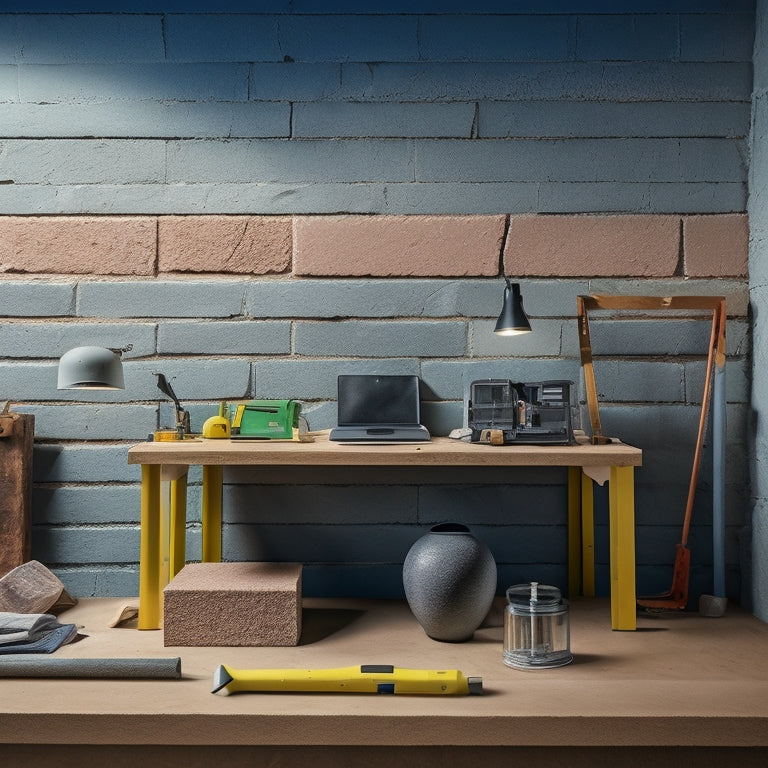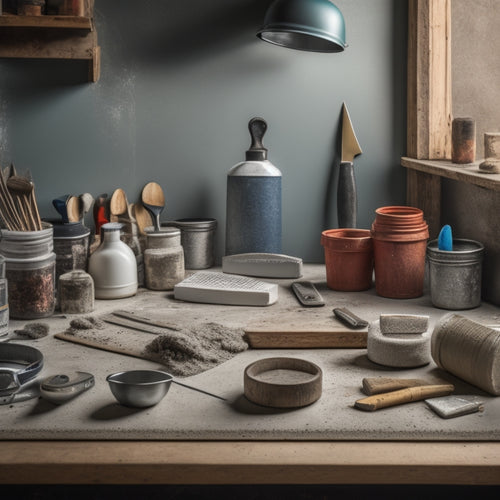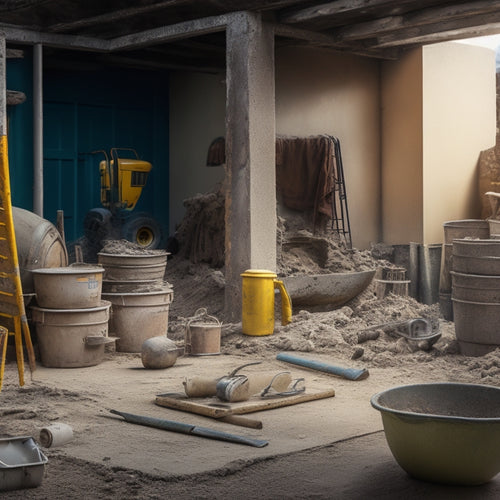
Essential Tools for Laying Concrete Blocks
Share
When laying concrete blocks, you'll need accurate mixing and measuring equipment, such as a mixing bucket, measuring tape, and level, to achieve perfect consistency. Specialized tools like a mortar mixer, tamping tool, and plumb bob are required for laying and leveling blocks. Cutting and shaping tools, such as a block splitter or masonry saw, guarantee precise fitting. Additionally, you'll need block handling and lifting equipment, site preparation necessities like a hand tamper or plate compactor, safety gear like hard hats and gloves, and finishing tools like a jointer or pointing trowel. Mastering these essential tools is just the first step in building a strong and stable concrete block structure.
Key Takeaways
• Accurate mixing and measuring equipment, such as a mixing bucket, measuring tape, and scoop, are crucial for achieving perfect concrete consistency.
• Laying and leveling tools, including a spirit level, tamping tool, and screed board, ensure a stable and straight concrete block structure.
• Specialized tools like block splitters or masonry saws are necessary for cutting concrete blocks to fit specific dimensions and creating clean, precise cuts.
• Block handling and lifting tools, such as block carts, dollies, and wooden or plastic spacers, aid in careful block transportation and stacking.
• Safety gear, including personal protective equipment and well-ventilated workspaces, are essential for a hazard-free concrete block laying process.
Mixing and Measuring Equipment
When preparing to lay concrete blocks, you're mixing and measuring cement, sand, and water to achieve the perfect consistency. This requires accurate and reliable mixing and measuring equipment. A mixing bucket or wheelbarrow is essential for combining the ingredients, and a mixing stick or trowel is necessary for achieving the right consistency.
To guarantee measuring accuracy, you'll need a measuring tape, level, and a scoop or trowel for precise measurements.
Mastering mixing techniques is vital for achieving the perfect blend. You'll need to follow a specific ratio of cement to sand to water, and mix the ingredients in a specific order. Overmixing can lead to weak blocks, while undermixing can result in poor adhesion.
Measuring accuracy is also critical, as incorrect ratios can compromise the structural integrity of the blocks. By using the right equipment and techniques, you'll be able to achieve a strong, durable, and long-lasting concrete block structure.
With the right tools and expertise, you'll be able to lay concrete blocks like a pro.
Laying and Leveling Tools
When you're laying concrete blocks, you'll need to make certain the surface is level and plumb to achieve a stable and straight structure.
You'll use specialized tools to check the surface's elevation and verify that your block courses are properly aligned.
Leveling the Surface
Before laying concrete blocks, you must guarantee the surface is level and even, as any deviations can lead to structural weaknesses and compromised integrity.
To achieve this, you'll need to employ effective leveling techniques. Start by evaluating the surface drainage, making sure that water flows freely and doesn't accumulate, which can cause erosion and unevenness.
Next, use a spirit level and a straightedge to identify any deviations from the horizontal plane. Mark these areas and use a leveling tool, such as a tamping tool or a screed board, to make the necessary adjustments.
It's vital to work in small sections, checking your progress frequently to avoid over- or under-compensating. Remember, a level surface is essential for a strong and durable structure.
Take your time, and don't be afraid to re-check your work to confirm accuracy. By following these steps, you'll be able to create a solid foundation for your concrete blocks, giving you the power to build with confidence.
Checking Plumb Lines
You'll need to verify the plumb lines of your concrete block structure by confirming that all vertical elements, such as corners and door and window openings, are perfectly aligned and perpendicular to the foundation. This is vital to maintain the structural integrity and aesthetic appeal of your project.
To achieve this, you'll need a plumb bob, a small but essential tool that helps you establish a reference point for vertical alignment. Suspend the plumb bob from the top of the wall or corner, allowing it to dangle freely. Then, use a level to confirm the string is perfectly vertical. This will give you a precise reference point to check the alignment of your blocks.
As you lay each course, use the plumb bob to verify that the blocks are aligned with the vertical elements. Make adjustments as needed to maintain perfect vertical alignment. By doing so, you'll guarantee that your concrete block structure is strong, stable, and visually appealing.
Block Cutting and Shaping
When you're working with concrete blocks, you'll often need to cut them to fit specific dimensions or shape their edges to achieve a precise fit.
To do this, you'll require specialized tools designed for block cutting and shaping.
You'll need to master the techniques for cutting block dimensions and shaping block edges to guarantee a professional-looking finish.
Cutting Block Dimensions
Measure the block dimensions carefully to confirm accurate cuts, as even a slight miscalculation can lead to wasted material and costly rework.
You'll need to verify block dimension accuracy to achieve a professional-looking finish. To do this, employ reliable measurement techniques that account for the block's length, width, and height.
Here are three essential steps to follow:
-
Verify the block's nominal dimensions against the manufacturer's specifications to confirm you're working with the correct sizes.
-
Use a tape measure or caliper to record the block's actual dimensions, taking into account any variations or tolerances.
-
Double-check your calculations before making the cut to avoid mistakes that can lead to rework or material waste.
Shaping Block Edges
To guarantee a precise fit and a professional-looking finish, accurately shape the block edges using specialized tools and techniques. You'll need to master various edge shaping techniques to create clean, precise cuts that fit together seamlessly.
A block splitter or a masonry saw is essential for shaping block edges. These tools allow you to create different block edge profiles, from smooth and rounded to rough and textured.
When shaping block edges, it's vital to follow specific techniques to achieve the desired profile. For instance, you can use a block splitter to create a concave or convex edge, or a masonry saw to make a straight cut. You can also use a carbide-tipped blade to cut curves or irregular shapes.
Remember to always wear protective gear, including gloves and safety glasses, when operating power tools. With the right tools and techniques, you'll be able to create precise block edge profiles that guarantee a strong, durable structure.
Mortar Application Essentials
You'll need to prepare a consistent mortar mix, achieving the ideal workability and consistency for efficient block laying. Mortar consistency is essential, as it directly affects the quality of the bond between the blocks. You'll want to aim for a mix that's not too runny or too stiff, allowing for easy spreading and adequate bonding.
There are several mortar types to choose from, each with its own strengths and weaknesses. For general-purpose block laying, a Type S mortar is a popular choice. This type of mortar offers a good balance of strength, durability, and workability.
When preparing your mortar mix, keep the following in mind:
-
Use the correct ratio of cement to sand: A general rule of thumb is one part cement to two parts sand.
-
Add the right amount of water: Mix the mortar to a consistency similar to thick batter.
-
Use a mortar mixer or trowel to mix and apply: This guarantees a consistent mix and efficient application.
Block Handling and Lifting
With your mortar mix prepared, it's time to turn your attention to handling and lifting the concrete blocks, a process that requires careful planning and execution to avoid damage and guarantee accurate placement.
You'll need to take into account the block transportation methods that will get the blocks from the storage area to the construction site. This may involve using block carts, dollies, or even manual carrying, depending on the size and weight of the blocks. Regardless of the method, it's crucial to make certain the blocks are properly secured to prevent damage or loss during transport.
Once you've transported the blocks to the site, you'll need to employ effective block stacking techniques to organize them for easy access. This includes creating stable, level stacks with blocks aligned squarely on top of each other, and using wooden or plastic spacers to separate them.
Site Preparation Necessities
Before commencing block laying, verify the construction site is thoroughly cleared of debris, obstacles, and vegetation to provide a clean, flat, and stable surface. This initial step is vital, as it sets the foundation for a successful project. You'll want to guarantee the site is level, compacted, and dry to prevent any settlement or water damage issues down the line.
To achieve this, consider the following site preparation necessities:
-
Soil Compaction: Use a hand tamper, plate compactor, or roller to compact the soil and prevent settlement. This is especially important for areas with poor soil quality or high water tables.
-
Drainage Considerations: Confirm proper drainage by sloping the site away from the foundation and installing drainage systems, such as French drains, if necessary.
-
Subgrade Preparation: Verify the subgrade is stable and compacted, and make any necessary repairs to cracks or unevenness.
Safety Gear and Protection
As you prepare to lay concrete blocks, don your personal protective equipment (PPE) and assure a safe working environment by identifying potential hazards and mitigating risks.
You'll need safety glasses or goggles to shield your eyes from debris, and a dust mask to prevent inhaling harmful particles. Wear steel-toed boots with slip-resistant soles to prevent falls, and gloves to protect your hands from cuts and abrasions. A hard hat is also essential to safeguard your head from falling objects.
Develop and implement strict safety protocols to guarantee a hazard-free workspace. Ensure good ventilation to prevent the buildup of harmful fumes, and keep the area well-lit to prevent tripping. Use warning signs and barriers to cordon off the work area, and designate a first-aid kit and emergency response plan.
Your protective equipment should be in good condition, properly fitted, and regularly inspected. By prioritizing safety, you'll avoid accidents, reduce downtime, and increase productivity.
Finishing and Smoothing Tools
You'll need a range of finishing and smoothing tools to achieve a professional-looking finish on your concrete block walls, starting with a jointer or pointing trowel to fill gaps and create a uniform surface. This trowel type is ideal for filling joints and creating a smooth, even surface.
To achieve a high-quality finish, you'll also need:
-
Float trowel: for applying and smoothing out mortar, and creating a flat, even surface.
-
Edger trowel: for creating clean, sharp edges and corners, and for finishing areas where a float trowel can't reach.
-
Tamping tool: for compacting and leveling the mortar, ensuring a strong bond between the blocks.
Mastering various finishing techniques, such as floating, edging, and tamping, will allow you to achieve a flawless finish on your concrete block walls.
By using the right tools and techniques, you'll be able to create a surface that's both visually appealing and structurally sound.
With practice and patience, you'll be able to produce professional-looking results that will last for years to come.
Frequently Asked Questions
How Do I Prevent Concrete Blocks From Getting Stained During Construction?
When building with concrete blocks, you'll want to prioritize stain prevention to maintain their appearance.
To do so, you'll need to apply protective coatings before construction begins. Sealants like silane or siloxane-based products create an invisible barrier, repelling water and stains.
Apply them according to the manufacturer's instructions, and you'll be able to enjoy your concrete blocks' original look for years to come.
Can I Use a Hammer Drill as a Substitute for a Block Chisel?
Imagine you're working on a high-rise building, and you need to make precise cuts in concrete blocks to fit around pipes.
Can you use a hammer drill as a substitute for a block chisel? While it's tempting, it's not recommended. Hammer drills are designed for drilling, not chiseling. They can cause blocks to shatter or crack, leading to costly rework.
Instead, invest in a block chisel, which is specifically designed for this task, and master techniques like 'plug and feather' or 'wedge and shims' for precise control.
What Is the Ideal Temperature for Laying Concrete Blocks?
When laying concrete blocks, you need to verify the ideal temperature for peak bonding and strength.
You'll want to aim for temperatures between 40°F and 90°F (4°C and 32°C), with a prime range of 50°F to 70°F (10°C to 21°C).
Avoid extreme temperatures, as they can compromise the block's structural integrity.
How Often Should I Clean My Concrete Block Laying Tools?
You know that regular tool maintenance is essential to guarantee peak performance and extend the lifespan of your equipment.
When it comes to cleaning your concrete block laying tools, you should make it a habit to clean them daily, or at least after each use.
Employ effective cleaning techniques, such as wire brushing and pressure washing, to remove stubborn mortar and debris.
This diligence will pay off in the long run, saving you time and money.
Can I Lay Concrete Blocks in the Rain or During Winter?
You're about to commence on a construction journey, but the weather forecast is calling your plans into question.
Think of your concrete blocks as a delicate flower - they need the right environment to bloom. Laying them in the rain or during winter can be disastrous, as excess moisture can weaken the bond between blocks and mortar.
Take weather considerations seriously and exercise winter precautions, like using specialized admixtures and protecting your work from freezing temperatures, to guarantee a strong and durable structure.
Conclusion
As you lay the final block, your project takes shape, a tribute to your skill and preparation.
The tools you've wielded are more than just instruments - they're the keys to unfastening a strong, stable foundation.
Just as a master builder selects each brick with care, you've chosen the essential tools to construct a lasting edifice.
With every layer, your confidence grows, a fortress of expertise that will weather any storm.
Now, stand back and admire your handiwork - a monument to your craftsmanship.
Related Posts
-

Essential Tools for Concrete Wall Covering Projects
When tackling a concrete wall covering project, you'll need a range of essential tools and equipment. For cleaning an...
-

Free Design Tools for Concrete House Planning
You can kick-start your concrete house planning project without breaking the bank, as there are several free design t...
-

What Tools Are Needed for Concrete Wall Foundations
You'll need a thorough array of tools and equipment to construct a concrete wall foundation that meets structural int...


